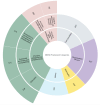Exploring the landscape of Canadian midwifery research: strengths, gaps and priorities - results of a scoping review
- PMID: 39672589
- PMCID: PMC11647286
- DOI: 10.1136/bmjopen-2024-087698
Exploring the landscape of Canadian midwifery research: strengths, gaps and priorities - results of a scoping review
Abstract
Objectives: The 2014 Lancet Series on Midwifery developed the Quality of Maternal and Newborn Care (QMNC) framework outlining care needed for all childbearing people and newborns. Furthermore, this was a global call to action to invest in research capacity building. While evidence-informed care is a cornerstone of midwifery practice, there has been limited exploration of how Canadian midwifery research priorities within the Canadian context align with the global framework. In response to the call from the Lancet series, this scoping review aimed to investigate the current strengths and gaps of midwifery research in Canada. Secondarily, our goal was to map existing Canadian evidence to the QMNC framework to guide future priority setting and build research capacity.
Design: A scoping review.
Data sources: We searched nine electronic databases for articles up to 2022, inclusive: AMED (Allied and Complementary Medicine), CINAHL, EconLit, EMBASE, HealthSTAR, MEDLINE, PsycINFO, EmCare and Web of Science.
Eligibility criteria for selecting studies: We included research conducted by (a) Canadian midwives on Canadian and non-Canadian populations, (b) international midwives on Canadian midwifery populations or (c) non-midwife researchers on Canadian midwifery populations.
Data extraction and synthesis: We analysed data using categories from the Lancet Series' QMNC framework. At least two independent reviewers conducted screening and data extraction.
Results: We identified 590 articles for inclusion. Most Canadian midwifery research is related to organisation of care and care providers, clinical practice categories including promoting normal physiological processes during pregnancy, research pertaining to prenatal and intrapartum periods, and policy. Research gaps included neonatal and postpartum outcomes, midwifery education, and midwifery values and philosophy. Lastly, there were gaps in the number of randomised trials and systematic reviews, which may impact guidance of clinical decision-making.
Conclusions: There has been an exponential increase in midwifery-led research in Canada. Assessment against the QMNC framework has highlighted gaps related to research conduct, clinical and non-clinical research focuses. Identifying midwifery research priorities is an important next step of consolidating Canadian research evidence. Future directions may include collaboration with midwifery stakeholders to prioritise research topics related to improving care for clients, strengthening the profession and building research capacity.
Keywords: Capacity Building; Health Services; Midwifery; Person-Centered Care; Research Design; Review.
© Author(s) (or their employer(s)) 2024. Re-use permitted under CC BY-NC. No commercial re-use. See rights and permissions. Published by BMJ Group.
Conflict of interest statement
Competing interests: None declared.
Figures



References
-
- Canadian Association of Midwives Discover midwifery across Canada. [01-May-2024]. https://canadianmidwives.org/about-midwifery/ Available.
-
- McRae DN, Muhajarine N, Janssen PA. Improving birth outcomes for women who are substance using or have mental illness: a Canadian cohort study comparing antenatal midwifery and physician models of care for women of low socioeconomic position. BMC Pregnancy Childbirth. 2019;19:279. doi: 10.1186/s12884-019-2428-y. - DOI - PMC - PubMed
Publication types
MeSH terms
LinkOut - more resources
Full Text Sources
Miscellaneous
